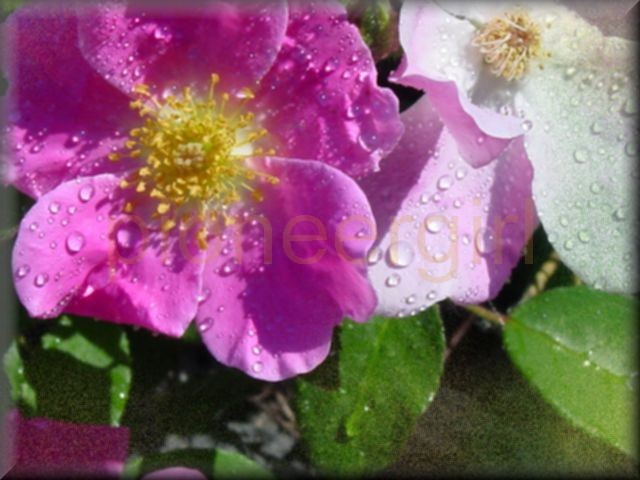wild prairie rose

A plant and flower of the genus Rosa, of many species and varieties, as the wild, canine or dog rose, the white rose, the red rose, the cinnamon rose, the eglantine or sweet brier, and the like. The rose is a shrub with oddly or alternately pinnate leaves and prickly branches. It is distinguished for the beauty and fragrance of its flowers, which, in the native state, have five petals of a delicate pink color. By cultivation the number of petals is greatly increased, and the flowers present very many different hues in the different varieties, which are so numerous as to be distinguished with difficulty. — Webster, 1882
 Last year the wild roses had exhaled their sweetness on the desert air and their leaves had fallen to the ground, at this time. They are not yet in blossom for 1888. – Kingsbury County News, June 22, 1888.
Last year the wild roses had exhaled their sweetness on the desert air and their leaves had fallen to the ground, at this time. They are not yet in blossom for 1888. – Kingsbury County News, June 22, 1888.
 Rose Wilder Lane was named for the wild rose, which includes – in South Dakota – the wild prairie rose (Rosa arkansana), the smooth wild rose (Rosa blanda), the prickly wild rose (Rosa acicularis), and the wild woods rose (Rosa woodsii).
Rose Wilder Lane was named for the wild rose, which includes – in South Dakota – the wild prairie rose (Rosa arkansana), the smooth wild rose (Rosa blanda), the prickly wild rose (Rosa acicularis), and the wild woods rose (Rosa woodsii).
The prairie rose is the most common wild rose in South Dakota, but can be grown in many states, from Montana to Texas. It is the state flower of both Iowa and North Dakota. The photo here is of a member of the rose family (Rosaceae), which contains over 100 species; this wild prairie rose grew outside my back door in Bozeman, Montana, in 2005. Laura Ingalls Wilder didn’t refer to a specific species of wild rose (she simply called them “wild roses”) in Pioneer Girl and Little Town on the Prairie. It’s not until These Happy Golden Years (see Chapter 16, “Summer Days”) that sister Mary exclaims that “nothing is sweeter than prairie roses.”
Wild prairie rose is a subshrub which grows from one to three feet tall, usually dying back each winter. Stems are covered with reddish thorns, which allows them to cling and creep to climb over other plants or along the ground. The five-petalled flowers are about two inches wide and vary from pink to white to deeper rose, depending on growing conditions. Flowers bloom on new growth only, with three or more flowers per branch. There are many varieties and hybrids of wild prairie roses. One subspecies is Rosa arkansana Porter, named for Thomas Conrad Porter (1822-1901); in 1874, he first described the prairie rose for science.
You can find prairie roses growing on the open prairies, in pastures, and along roads and wooded areas. Laura and Mary Ingalls gathered roses on the Ingalls homestead in De Smet, and there are wild roses still growing in the area. It is not the state flower of South Dakota, however; pasque flower has that honor.
In The First Four Years, Laura Ingalls Wilder wrote that she asked Almanzo what they should name the child they were waiting to be born, and he replied that they couldn’t pick a name because they didn’t know if it would be a boy or a girl. After a silence, Laura supposedly said, “It will be a girl and we will call her Rose.” In Pioneer Girl, Laura wrote this about wild roses: In June the wild roses bloomed. They were a low-growing bush and, when in bloom, the blossoms made masses of wonderful color, all shades of pink all over the prairie. And the sweetest roses that ever bloomed. A private note to daughter Rose in the manuscript added: You are their namesake, my dear.
While working on the Little House books, Laura wrote to her sister Grace to ask about the flowers that used to grow on the Dakota prairie. Although she didn’t mention roses in her reply, Laura mentioned them in her letter to Rose dated February 5, 1937: You remember the roses of course and have heard us tell about them.

rose / wild rose / prairie rose (LTP 6, 20; THGY 13, 16, 20, 23, 25, 28; PG)

